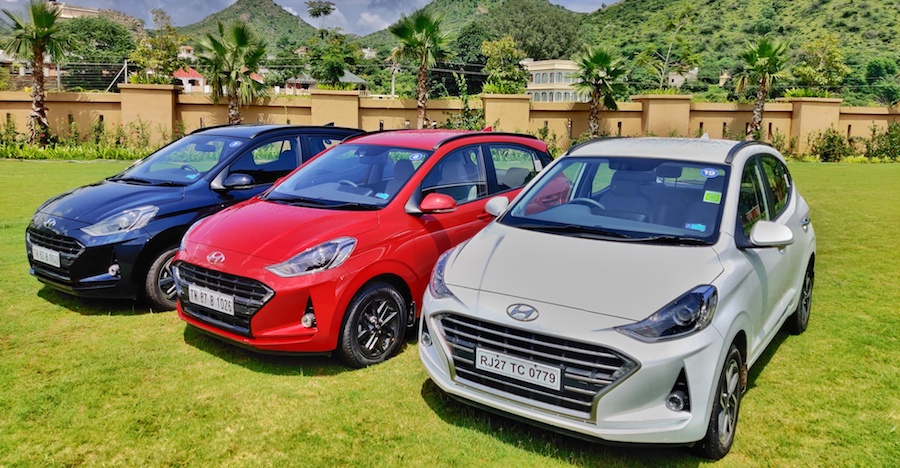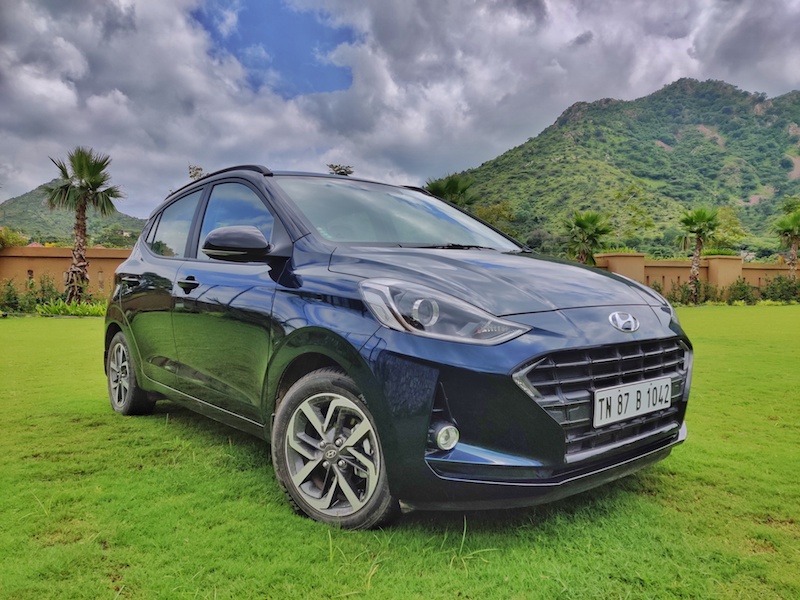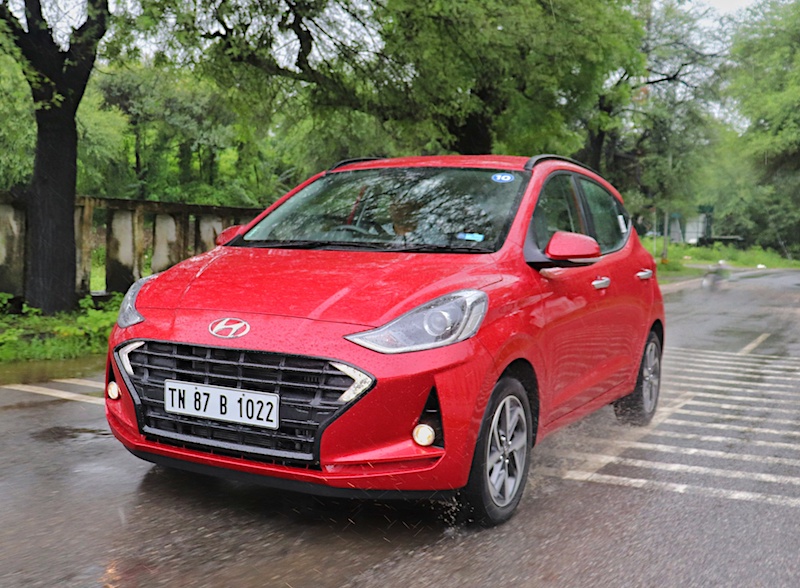Hyundai Grand i10 NIOS Diesel MT / AMT in CarToq’s first drive review


The Hyundai Grand i10 has been a successful product, offering a mix of comfort, features and value to consumers. Regular discounts have kept sales charts busy but the car was never associated with the term sportiness. This is where the third generation of the i10 comes into the picture.
Launched on 20th August with prices starting at Rs 4.99 lac, the Grand i10 NIOS is the latest entrant into the mid-size hatchback market. NIOS by the way means ‘more’ in Irish language and that is what I set out to explore about this new Hyundai in wet and lush green Udaipur earlier this week.
The design change
The NIOS is based on a heavily revised Grand i10 platform which has allowed designers a lot of free hand in terms of giving it a different appeal. In terms of dimensions first, the NIOS is larger than the older Grand i10. The front end is completely revised with larger headlamps that get projectors, boomerang shaped DRLS in the ever expanding grille and classy little round fog lamps. Parked next to the Grand i10, the NIOS does look premium and far more sportier.

The side profile isn’t too exciting as such but the 15 inch machined cut alloy wheels do look nice. Hyundai is known to offer some of the best looking alloy wheels in the business and the NIOS is no different. The C pillar has G-i10 branding and at the back, we feel its a mix of the older Grand and a particular car from Tata Motors. Don’t get me wrong here, the execution doesn’t look bad at all but its just that the front end is a bit too classy and the main talking point about the car.

The Sportz edition of the NIOS manual versions can also be ordered in two different dual tone color options of Aqua Teal and White. The latter looks stunning in my opinion though sadly we didn’t have this on the media drive event. These dual tone options get contrasting black coloured roof and another important change that I speak about below.

The new cabin
What you see here is the cabin of the dual tone option that offers an all-black theme as compared to black-beige for the regular models. I personally like this combination and it gels along nicely with the sportier theme of the car. As per the colour you pick (Aqua Teal or white), you get color coded seat stitching too.

Our Aqual Teal NIOS even had similar color inserts around the air-con controls and the side vents. The dual tone options, by the way, also get wireless charging which is otherwise missing for the normal Sportz variants. Sadly though, you cant opt for dual tone with the AMT NIOS. Why Hyundai, why?
The cabin has grown in size and there is more space at the back than its chief rivals the Swift. Ingress is superb for both the rows and we have no questions when it comes to the levels of quality on offer. Visibility has been an USP of the Grand i10 and this improves here too. The dash isn’t too high which means even for short drivers, having a clear view of the road ahead isn’t an issue.

The higher versions get a new and larger 8-inch touch screen infotainment that also offers a rear view monitor on the move, better audio quality and the usual set of connectivity options. The speedometer console too is new with an analogue tacho and digital display for the speed, odometer and other parameters for the driver.
And while front seats are comfortable and driver ergonomics spot on, the front head rests are non adjustable and you do not get a front arm-rest either. Step into the back seat and you will like the almost flat floor, windows that drop down completely and comfort from the seats. Here again, no central arm-rest or a 60:40 split for the row. Why?
Boot space now stands at 260 litres which is more or less similar to that of the Maruti Suzuki Swift.
The drive
The Grand i10 NIOS carries forward the same 1.2-litre petrol and 1.2-litre diesel units. The former is the same engine that has been doing duties for years now and powers the Xcent and i20 as well. Refined and tuned for economy, though I didnt get a chance to drive it at the event, my colleagues were all praises for it.

I instead deduced to spend time with the 1.2-litre diesel unit. For starters, this is a 3-cylinder unit (as compared to a proper 4 pot on the Swift) but the typical vibrations and harshness associated with such a set-up is kept outside the cabin. Yes, the car does shake a bit when you start it, but in daily usage, till the time you aren’t gunning it, the smoothness levels are just fine.
Max power is rated at 75 PS and peak torque at 190 Nm. These are similar to that of the Swift but far less than the Figo – 100 PS and 215 Nm. This Ford still has the benchmark in terms of low end punch, top end performance and fuel economy. Back the NIOS, it is the first time that a diesel Hyundai is being offered with an optional AMT. This e-AMT (electronic actuation) first made its debut in the Santro and now a tuned version does duties here.

Thanks to all that torque lower down in the rev range (Hyundai claims their diesel offers 10% extra low end torque than the Swift), the AMT-Diesel combination works very well, even for low speed traffic conditions. Shifts are smooth and once you get used to the lag, you can keep up with fast moving traffic without trying too hard. Pedal to metal, it takes about 6.2 to 6.3 seconds for the 0-60 km/h dash.
The manual NIOS diesel scores higher marks for smooth shift quality and a not so heavy clutch. Certified economy is over 20 kmpl for both the AMT and MT variants.
Ride and Handling
This is one area where Hyundai has ensured the NIOS behaves differently without compromising on the comfort factor that the Grand i10 has always been known for. For starters, the steering remains a delight for city runs and light enough even for parking speeds. It does retain some amount of weight at higher speeds but frankly, if grinning moments is what you seek, look elsewhere.

We had ample bad roads in and around Udaipur thanks to extended rains that eat away into tarmac and were impressed with the set-up here. It does absorb undulations well without any wallowing effect or bottoming out. There is an underlying firmness that only comes handy when driving with a full load of passengers or at highway speeds.
Another area where the Grand i10 NIOS fares well is in the insulation department. Its easy to have a peaceful conversation with the rear passengers and this will be loved by owners and their families alike.

Verdict.
Prices start at Rs 4.99 lac ex-showroom Delhi and though this undercuts the Swift, Maruti dealers are offering benefits to the tune of Rs 40,000. Its own cousin, the older Grand i10, that continues to be sold side by side comes with benefits of upto Rs 70,000. With these equations in mind, the pricing doesn’t seem too tempting.

However, as a product, there are improvements all around. And then add-ons like the variable warranty as per your usage, optional all-black interiors and the overall feel good factor. The NIOS takes over from where the Grand i10 leaves and offers an excellent blend of comfort and sportiness. The duo will certainly eat into the sales of the market leader in months to come.